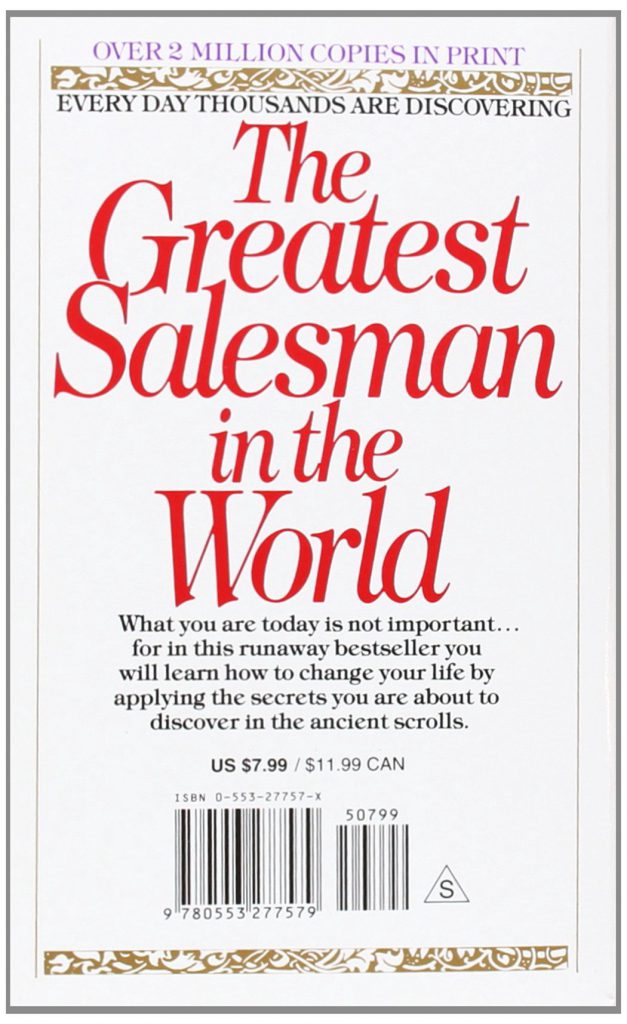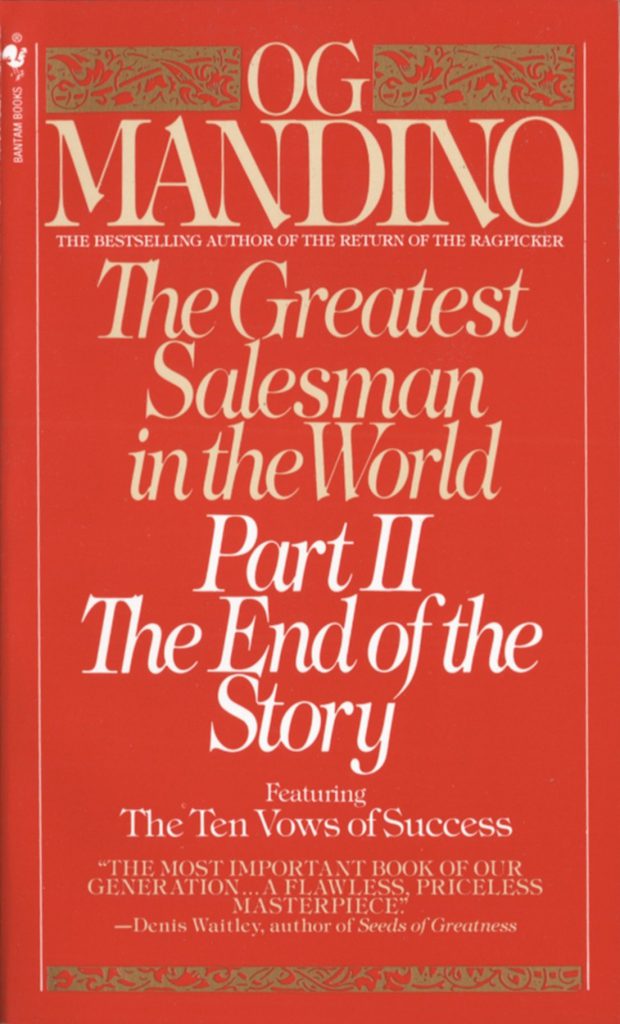The 10 Ancient Scroll for Success
The Greatest Salesman in the World
The Greatest Salesman in the World is a book, written by Og Mandino, that serves as a guide to a philosophy of salesmanship, and success, telling the story of Hafid, a poor camel boy who achieves a life of abundance. The book was first published in 1968, and re-issued in 1983 by Bantam. A hardcover edition was published by Buccaneer Books in June, 1993. In 1970, Success Motivation Institute purchased the rights to produce the audio recording.
If Mandino’s suggested reading structure is followed, it would take about 10 months to read the book.
The instructions are to read Scroll I three times a day for thirty days straight. Only after completing the thirty days of reading Scroll I, should you continue to Scroll II and so forth through Scroll X.

.
The Ten Scrolls – Directory
01. The Scroll Marked 01 + Audio
I will Form Good Habits and Become their Slave
02. The Scroll Marked 02 + Audio
Greet Each Day With Love In Your Heart
03. The Scroll Marked 03 + Audio
I Will Persist Until I Succeed
04. The Scroll Marked 04 + Audio
I am Nature’s Greatest Miracle
05. The Scroll Marked 05 + Audio
Live Each Day as if it Were Your Last
06. The Scroll Marked 06 + Audio
Master Your Emotions
07. The Scroll Marked 07 + Audio
The Power of Laughter
08. The Scroll Marked 08 + Audio
Multiply Your Value Every Day
09. The Scroll Marked 09 + Audio
All is Worthless Without Action
10. The Scroll Marked 10 + Audio
Pray to God for Guidance
.
The book’s philosophy
This is a book on the philosophy of life, and is not just applicable to being a great salesman.
His primary message was to “do it now”. In the marking of Scroll IX, “I will act now” is written 18 times. Actor Matthew McConaughey cited this book as having changed his life. The book is also recommended by Tariq Jameel, who says that the book should be read by everyone looking for success in his life.
.
Quotes
“You were not created for a life of idleness. You cannot eat from sunrise to sunset or drink or play or make love. Work is not your enemy but your friend. If all manners of labor were forbidden to thee you would fall to your knees and beg an early death.”
To learn and master anything, one has to pay the price in time and concentration, until it becomes part of one’s personality and habit in living.
No other trade or profession has more opportunity for one to rise from poverty to great wealth than that of salesman.
Rewards are great if one succeeds but the rewards are great only because so few succeed.
Obstacles are necessary for success because in selling, as in all careers of importance, victory comes only after many struggles and countless defeats.
.
The Greatest Salesman in the World part two, the end of the story
This is a sequel to Mandino’s 1967 bestselling book, published in 1988 and set forty years later than the first part; the main character Hafid is in a sad state, mourning the loss of his wife, Lisha. The story starts years into Hafid’s seclusion, when a dream convinces him to see a stranger that turns up on his doorstep and pulls Hafid out of retirement to embark on a new adventure: a speaking tour to enlighten others about the principles enclosed in The Ten Scrolls.
.

.
The Greatest Salesman in the World, by Og Mandino
Whether we’d like to be Top Salesperson of the Month, finish writing that novel, or lose 15 pounds, we all have goals we want to attain. But doing it can be daunting. Part self-help techniques, part sales manual, and part Christian allegory, The Greatest Salesman in the World addresses ways we can establish daily habits to strengthen our resolve and character, which will help us achieve our goals. The book’s 10 principles provide a framework centered around positive thinking and self-discipline, the building blocks of any kind of self-improvement.
.
1-PAGE SUMMARY
Fast Summary of Shortform’s Guide to The Greatest Salesman in the World
Part self-help techniques, part sales manual, and part Christian allegory, The Greatest Salesman in the World delivers a prescription for how to live your life more successfully by utilizing 10 character-building principles. Written by insurance salesman Og Mandino in 1968, the book emphasizes that to achieve any goal, you need to develop the habits and attitudes of a great salesperson, which means acquiring self-confidence, emotional control, persistence, generosity, humor, and humility.
The Story Behind the Principles
The 10 principles are taught through the parable of a poor camel boy in Biblical times. Hafid wants to learn the art of selling so he can become a wealthy merchant. Hafid’s mentor, a highly successful salesperson, sees that the young boy is both ambitious and generous, so he rewards him with a chest full of 10 scrolls inscribed with the secrets of selling. But the precious scrolls come with caveats: Hafid must always give generously to those less fortunate, and he must keep the scrolls a secret until he meets their next rightful owner.
Hafid uses the scrolls to amass a great fortune and eventually reaches old age. As he nears his death, he gives away almost everything he owns while he waits for the scroll’s successor to appear. When that person arrives, it turns out to be the Apostle Paul, who will use the scroll’s lessons to “sell” Jesus’s teachings to the world.
.

The Scrolls’ Lessons
Scroll #1: Form Good Habits
Create a better future for yourself by replacing bad habits with good ones. Today is a new day in which you can spend your time and energy engaged in practices and activities you want to cultivate instead of negative behaviors. With practice, any new action becomes easy, so start forming better habits today.
.
Shortform Example:
Say you want to eat healthier meals, but you begin each morning by stopping at the fast-food drive-thru on the way to work. Replace this bad habit with a better one—get up 15 minutes earlier and make yourself a delicious, healthy breakfast. If you repeat this practice over many days, it will become a normal part of your routine. You will be a slave to a good habit rather than a bad one.
.

Scroll #2: Love Others
Approach every person on earth with unconditional love. Recognize people’s innate goodness even if they aren’t showing it. Use love and generosity as tools to attract people to you. The love you send out into the world will come right back to you.
.
Shortform Example:
You think your colleague is arrogant and overbearing, and you avoid him as much as possible. Tomorrow, seek him out and ask him a question about his family or work, or pay him a genuine compliment. Even words as simple as “that’s a great tie you’re wearing” can be a loving gesture. Genuinely loving words and actions may turn this difficult person into a valued friend.
.
Scroll #3: Don’t Quit
Don’t quit. Perseverance and persistence are critical sales skills and also life skills. Failures are merely challenges on the path to success. Success rarely comes right away—it typically arrives at the end of your efforts, not the beginning.
.
Shortform Example:
Even after a full day of hearing “no” from potential buyers, a great salesperson doesn’t allow herself to give up. When you’re weary at the end of the day and want to go home, challenge yourself to make one more sales call. Every single call is one step on the journey to making a sale.
.
.

.















